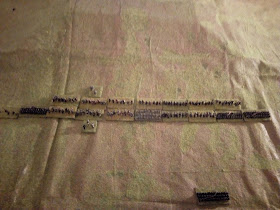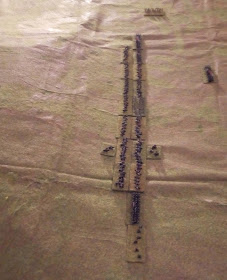Although I have managed to get a couple of games in with the children, today is the first full-scale battle I have played in my new home. Despite having big plans for the next few years, I settled on something realtively straightforward to christen my new table: one of the superb tabletop teasers written by Charles Grant and published in both
Battlegames Issue 08:
and the collection of
Battlegames tabletop teasers:
The Scenario: The aim of the scenario is to control a town and its approaches in the middle of a valley, hotly contested by two forces. I used the same forces as given as the example in the scenario, Napoleonic-era Austrians and French.
 |
| The river valley: gentle hills surround the small fordable river, which contains a large-ish town situated on the river bed. The Austrians are apporaching from the top-left, the French from the bottom-right |
 |
| Looking down the valley from the right (French) side |
 |
| A slightly closer look at the town. |
The Orders of Battle:
The forces for both sides were approximately doubled to reflect the different battle sizes aimed at by the Grant Napoleonic rules and the Polemos General de Division rules respectively. This meant both sides had a large infantry division, a light cavalry brigade and a heavy cavalry brigade.
Imperial French:
C-in-C: Gen Alliot (Capable)
1st Infantry Division (Gen Arnoux - Capable)
3 x Infantry Brigades each of 4 bases of Trained SK1 Infantry
1 x Infantry Brigade of 3 bases of Trained/Elite SK1 Infantry
1 base of 8lb Trained Foot Battery
Light Cavalry Brigade
3 bases of Trained Light Cavalry
Dragoon Brigade
3 bases of Trained Dragoons
1 base of 4lb Horse Artillery
Imperial Austrian:
C-in-C: Gen Fichte (Capable)
1st Infantry Division (Gen Schiller - Plodding)
4 x Infantry Brigades each of 4 bases of Trained SK0 Infantry
1 base of 6lb Trained Foot Battery
Light Cavalry Brigade
3 bases of Trained Light Cavalry
Dragoon Brigade
3 bases of Trained Dragoons
1 base of 3lb Horse Artillery
As can be seen, very equal forces but with an advantage to the French in terms of the quality of their infantry and command.
Both sides arrived off the line of march in the following schedule:
Turn 1: Light Cavalry brigade and C-in-C
Turn 2: 2 Infantry brigades
Turn 3: Remaining infantry brigades and the divisional artillery
Turn 4: Heavy cavalry brigade
The Battle:
 |
| The French light cavalry arrives, with Gen Alliot at its head. |
 |
| As do their Austrian counterparts on the opposite side of the board. |
 |
| The Austrian light cavalry probe towards the town |
 |
| The French corps clambers up the slopes |
 |
| A wider view of the same |
 |
| The Austrians, handicapped by their plodding divisional commander, make more pedestrian progress towards the town. Some of the infantry begin to cross the stream. |
 |
| The lead elements of both armies begin to come with range |
 |
| The faster moving French have secured the area at the bottom of the town, whilst the Austrian infantry have just managed to get their first brigade across the stream |
 |
| The French are slightly more strung-out as the French C-in-C has concentrated his efforts on rapidly gaining position with his lead elements. |
 |
| The battle begins to develop its shape: cavalry and infantry face-off in mutual support to the south-west of the town, whilst French infantry cross the stream to try and extend their control onto the northern bank |
 |
| A closer view of this key point: the French have secured the southern suburbs, and are crossing to try and force the issue on the North-Eastern approach too. |
 |
| Gen Arnoux leads his troops into the attack! |
 |
| With mixed results! The French are in the ascendant upon the right, led by Gen Arnoux in person, but the other Austrians have delivered a devastating volley and the left-hand French units retreat in considerable disorder |
 |
| Pressing home their advantage, the Kaiserlichs surge forward and push the Frenchmen back into the stream |
 |
| Gen Alliot leads his grenadiers in an attempt to break the deadlock to the South of the town. |
 |
| The Austrian infantry hold on against Gen Arnoux's attack |
 |
| And the Austrian infantry are victorious!! Note the lead French battalion has been routed and the remaining French units are very shaken (the individual figures mark the level of disorder); Gen Arnoux falls at the head of his troops. |
 |
| A renewed Austrian attack breaks the French brigade in its entirety! |
 |
| Gen Alliot's attack fails; and the line is restored - he calls his artillery forward to resume the attack. Note that the Austrian infantry has dropped back a little from the southern suburb to create a stronger line. |
 |
| The victorious Austrian infantry surges across the stream and advances towards the French Dragoons. More Austrian infantry begin to envelop the southern suburb. |
 |
| The Austrians carry out a two-pronged assault against the French in the town, co-ordinated by Fichte and Schiller in person. |
 |
| ...menawhile, the Austrian infantry advances in its squared up the slopes. Note that the French infantry begin another attack on the far bank. |
 |
| With the battle going against him, Gen Alliot launches an all-out charge on the southern flank! |
 |
| Whilst the French infantry tries to come to grips on the Northern bank. Note that the Austrian infantry has made significant progress on the western axis of its attack on the southern suburb (somewhat against the odds, the French infantry have held on well on the other side) |
 |
| The Austrian infantry keep up continous pressure on the French dragoons. Note centre-left the French battalion routing away from the town's suburb. |
 |
| The French Dragoons launch a bold charge and are blessed with luck! The Austrians rout back towards the stream. |
 |
| However, the French light cavalry attack has not been blessed with success, and many of its units are routed or shaken. |
 |
| The Austrians hold off another French attack on the Northern bank. |
 |
| The French Dragoons pursue the routing Kaiserlichs. |
 |
| The French position dissolves entirely... |
 |
| ...and the field is full of routing French units. |
 |
| The Austrian position is now secure on both sides of the stream and only the French Dragoons remain fit for combat. The French commander admitted defeat at this point. |
Game Notes:
An exciting action to get back into the swing of things. The Austrians had the rub of the dice in this game, particularly in beating back the first French infantry assault - this was a really close and tough fight and the Austrian success here somewhat defined the game, enabling more freedom of Austrian manoeuvre in the centre. Although the French Dragoon charge was blessed with good fortune, the French light cavalry charge was more unfortunate - but that attack was something of a last-gasp effort anyway.
As usual, I was using the
Polemos General de Division rules, although with some minor modifications, these being the 'flatter' factors I have discussed previously, i.e:
Raw troops -1
Veteran troops +1
Uphill +1
Shaken -1
Towns are also given a defence factor of 1 rather than 2
All of the above worked fine.
The other modification was a slight change to the command rules, in that the rules that apply between commander and subordinate (if further than 6BW away or out-of-sight, only receive half TPs) is also applied to subordinate and group (double the order points required to carry out an action, unless the commander-in-chief is himself within 6BW and in sight of the group). This worked pretty well actually: if you are a Polemos player vaguely unhappy with the telepathic subordinate general to group aspect, then this is a solution that might work for you. But as ever, the rules continue to give an excellent game.
Figures from
Baccus 6mm, buildings a mixture of Baccus,
Total Battle Miniatures and
Leven Miniatures. The game cloth was about 6' x 3.5'. The game lasted for just over 20 turns and took just over 2 hours of play.



















































































